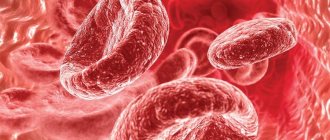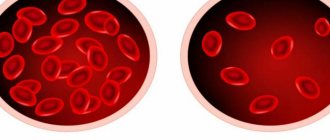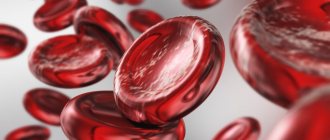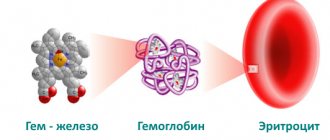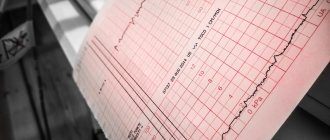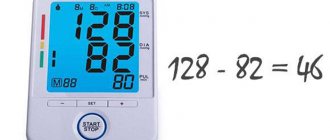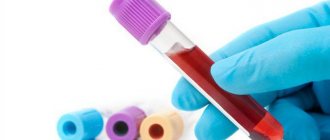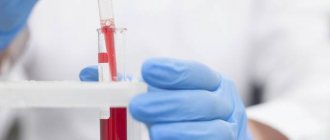What is the normal hemoglobin level in women?
Hemoglobin content is determined by a general blood test. Its normal value in women varies from 120 to 140 g/l. A higher rate may be observed in professional athletes (up to 160 g/l) or in women who smoke (up to 150 g/l). In such cases, a slight deviation is considered as a variant of the norm.
Doctors use a separate scale to assess the level of hemoglobin in the blood of pregnant women. The lower limit of normal in the first and third trimester of pregnancy is considered to be 110 g/l, in the second - 105 g/l. The upper value during the entire period of waiting for the child should not exceed 120 g/l.
The significant difference in normal values between pregnant and non-pregnant women is explained by physiological changes occurring in the body of the expectant mother. During gestation, the volume of circulating blood increases by 50%, so it becomes increasingly difficult for the bone marrow to supply sufficient hemoglobin. In addition, additional iron consumption is required for the formation of the placenta and the growing embryo.
| Group | Hemoglobin norm |
| Average level for all women | from 120 to 140 g/l |
| Smoking women | up to 150 g/l |
| Women doing sports | up to 160 g/l |
| Pregnant women in the 1st and 3rd trimester | 110 g/l |
| Pregnant women in the second trimester | 105 g/l |
Increased hemoglobin in women
The reasons for increased hemoglobin in women can be both physiological and pathological. The first include intense physical activity and prolonged exposure to hypoxic conditions (for example, living in a high mountain region). At the same time, the body begins to experience an acute lack of oxygen, which is compensated by the “overproduction” of red blood cells. Such deviations from the norm, as a rule, are always insignificant - within 10-20 g/l. They do not alarm doctors and do not require medical intervention.
The situation is much more serious if hemoglobin increases without obvious reasons. This may be a sign of dangerous pathologies, in particular heart disease, diabetes mellitus, intestinal obstruction or cardiopulmonary failure.
It is most dangerous when the hemoglobin concentration reaches 180-190 g/l. At the same time, there is an increase in blood viscosity, microcirculation processes are disrupted, and oxygen delivery to organs becomes difficult. Such patients are diagnosed with blueness of the tips of the fingers and toes, rapid fatigue, decreased appetite, absent-mindedness and irritability.
Long-term circulatory disorders lead to the development of thromboembolism (blockage of blood vessels). Therefore, excessively high hemoglobin levels are a condition that requires immediate treatment.
How to reduce hemoglobin in women?
The following measures can be used to reduce hemoglobin:
- Diet therapy. The patient is asked not to abuse foods high in iron: red meat, animal by-products (liver, kidneys, etc.). The consumption of foods that increase cholesterol levels and blood viscosity (butter, pork, caviar, confectionery) is limited. It is recommended to fill the diet with protein foods: legumes, white meat, fish. Fast food, carbonated drinks, canned food and semi-finished products are completely excluded. Also, during the treatment period, it is prohibited to take vitamin-mineral complexes containing vit. B12, folic acid and iron.
- taking antiplatelet agents. Such drugs thin the blood and reduce the risk of blood clots. However, you should not use them yourself without the appointment of a specialist - you can harm your health. You should consult your doctor about the rationale for using antiplatelet drugs.
- Search for the underlying disease. An increase in hemoglobin levels indicates a malfunction in the body. To identify the cause of the problem, the doctor must prescribe a comprehensive medical examination.
What is the danger of long-term anemia?
Even mild anemia, if persisted for a long time, can cause serious damage to health! Prolonged oxygen starvation of tissues (hypoxia) leads to metabolic disorders, accumulation of toxic metabolic products, and excessive load on life-support organs - the heart, lungs, as well as excretory organs - liver, kidneys.
As a result of chronic hypoxia, sclerotic processes develop in tissues and organs - normal, working tissue is replaced by sclerotic (conditionally “scar”), as a result of which organs begin to gradually lose their function - cardiosclerosis develops with manifestations of heart failure (shortness of breath, edema, decreased exercise tolerance ), heart rhythm disturbances, respiratory failure, the function of the liver, kidneys, blood vessels, endocrine organs, and brain suffers. A person, without noticing it, acquires chronic diseases, loses his ability to work, becomes emotionally labile, depressed, and his immunity decreases. In addition, against the background of chronic anemia, any acute disease, be it a viral infection, tonsillitis, or more serious illnesses, is much more severe, dangerous complications develop much more often due to the fact that there are simply no compensatory capabilities in the body, they are depleted by a long-term hypoxic state.
In order to avoid the development of chronic diseases against the background of anemia, long-term, debilitating, and sometimes expensive treatments, you must follow simple rules:
- undergo an annual preventive examination - for a healthy person it will be enough to take a general blood and urine test, undergo fluorography and visit a therapist, gynecologist (urologist) and dentist.
- When identifying symptoms of chronic diseases that can lead to the development of anemia, promptly correct them.
- If there are signs of chronic bleeding, promptly diagnose and treat the diseases that cause them.
This is especially true for women with gynecological problems . Often, women are accustomed to enduring all hardships and long, heavy menstruation is considered almost a variant of the norm! This is fundamentally wrong - on the one hand, very often after treatment it is possible to restore the normal menstrual cycle quite easily and there is simply no reason for anemia; on the other hand, long, heavy periods, especially in women after 40 years of age, can be the first symptoms of oncological diseases of the female sphere !
- anemia must be treated! Even if you have mild anemia, it is necessary to promptly correct your hemoglobin level - sometimes just a diet and a monthly course of taking iron supplements are enough to restore normal blood counts and prevent the development of adverse long-term consequences!
At the ACMD-MEDOX clinic, almost all the necessary research methods for diagnosing anemia are available. Comfortable conditions, professional specialists, and modern equipment will allow you to undergo the necessary examinations painlessly and in the shortest possible time.
Experienced doctors at our center will help you identify the first signs of anemia in the early stages, understand the causes of its occurrence and prescribe adequate therapy for the identified pathologies! Be healthy!
Low hemoglobin in women
A condition in which hemoglobin falls below normal is called iron deficiency anemia (or anemia). An experienced doctor is able to detect pathology even before undergoing laboratory tests, barely looking at the patient who contacts him. A pale face, dry skin, pockets in the corners of the mouth, dull hair and sluggish movements are the main symptoms of low hemoglobin. And if, in addition to this, a woman complains of increased fatigue, “spots” in the eyes and frequent dizziness, then the diagnosis is not at all in doubt.
In pregnant women, anemia is often accompanied by eating and smell disorders. The desire to eat chalk, coal, sand, smell whitewash or gasoline is by no means a “cute whim” of the expectant mother, but a reason to see a doctor.
The danger of anemia lies in the insufficient supply of oxygen to the tissues. At the initial stages of the disease, the body tries to cope with the lack of a vital element, depriving it of the least significant organs from its point of view (hair, nails, teeth). However, over time, oxygen deficiency increases and everyone has to “starve”, including the brain and heart. In order to prevent serious complications, it is important to identify and eliminate the cause of the disease at an early stage of its development.
Causes of low hemoglobin in women
Anemia can be caused by:
- Poor nutrition. In order for hemoglobin to be synthesized in the required quantity, a sufficient amount of iron must be supplied to the woman’s body with food. Its main source is animal products: meat, liver, kidneys. Plants also contain iron, but in a form that is much less easily absorbed. This is why vegetarianism and low-meat diets are becoming one of the most common causes of anemia. A decrease in hemoglobin can also be caused by excessive consumption of foods that inhibit iron absorption: coffee, tea, chocolate, cereals.
- Lack of folic acid, vit. C or Vit. B12 in the body. All these elements play an important role in the formation of hemoglobin. Vitamin deficiency B12 is most often caused by helminthic infestation, and a lack of vit. C and folic acid - an unbalanced nutritional diet.
- Blood loss. They can be both obvious (with systematic donation, heavy long menstruation, uterine bleeding) and hidden (blood loss associated with hemorrhoids, ulcerative lesions of the digestive tract, polyps in the large intestine, etc.).
- Hypothyroidism. The thyroid hormone, thyroxine, regulates the absorption of iron in the intestines. Its deficiency also entails a lack of hemoglobin.
- Diseases of the digestive system. Gastritis, ulcerative lesions of the stomach or intestines lead to thinning of the mucous membrane of the digestive tract, as a result of which iron practically ceases to be absorbed.
- Premature death of red blood cells. This condition can be caused by long-term infectious diseases (hepatitis, tuberculosis, etc.) or immune disorders (for example, lupus erythematosus, rheumatoid arthritis).
- Sedentary lifestyle. Physical activity is one of the factors influencing the synthesis of red blood cells. If the blood is not rapidly dispersed throughout the body, the brain receives signals that there are “enough” red blood cells and their additional synthesis is not required.
- Stress. They can cause a decrease in appetite and, as a result, insufficient intake of iron from food.
On topic: 5 superfoods to quickly increase hemoglobin!
Symptoms and causes of low hemoglobin
Insufficient hemoglobin content in the blood provokes frequent fatigue, malaise, drowsiness, loss of strength, and bad mood. Patients also complain of constant headache and dizziness. In addition, there is pallor of the skin, poor appetite, tinnitus, cold hands and feet, perversion of taste, pain in the muscles, and the frequent development of colds and viral infections.
In severe cases, the person may lose consciousness. Therefore, in this case, you should definitely visit a doctor and undergo the necessary tests.
Nothing happens for nothing. Including hemoglobin, it cannot decrease without reason. This deficiency in the body is indicated by serious diseases and certain conditions:
- Iron deficiency anemia in chronic form.
- Various bleeding.
- Long-term gastritis.
- Inflammatory bowel pathologies, dysbiosis.
- Time period after surgery.
- Oncology of blood cells.
- Neoplasms in the digestive tract.
- Hepatitis.
- Tuberculosis, pneumonia.
- Iron deficiency.
- Vitamin B12 and folic acid deficiency.
- Destruction of the structure of red blood cells due to severe pathologies.
- Following a diet that involves limiting a large amount of food.
The reasons for a decrease in hemoglobin can be various conditions. However, the greatest impact on protein deficiency is exerted by various blood losses due to surgery, trauma, wounds, and hemorrhoids.
In females, a decrease in hemoglobin most often occurs during menstruation, which lasts more than 5 days.
What to do if a woman’s hemoglobin is 60-80?
A hemoglobin level below 80 g/L is considered severe anemia. Correction of the condition is carried out taking into account the factor that caused it. To find out the cause of the pathology, the woman is asked to undergo a series of tests and see specialists: a gynecologist, a gastroenterologist, an endocrinologist, and a nutritionist. After identifying the underlying disease, the patient is selected a set of therapeutic measures aimed at combating it.
Proper nutrition is definitely recommended. A woman's daily diet should include foods rich in iron and vitamins.
These include:
- beef, lamb, white rabbit meat,
- liver, tongue, kidneys,
- egg yolk,
- dried apricots, raisins, prunes, figs,
- apple and pomegranate juice,
- buckwheat soups and porridges,
- legumes,
- sprouted grains of wheat,
- rosehip decoction,
- plums, green apples,
- almonds and walnuts.
The body itself is able to regulate the amount of iron absorbed from food - if there is a shortage, it increases and vice versa.
Drinking plenty of fluids is very useful for low hemoglobin. Doctors advise taking 1/4 cup of plain water and juices every 30 minutes.
On topic: List of foods to increase hemoglobin
